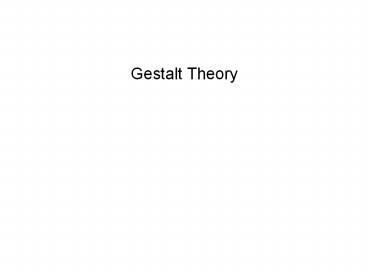Gestalt Theory - PowerPoint PPT Presentation
Title:
Gestalt Theory
Description:
Gestalt Theory Gestalt Theory Definition (useful to us): a concerte individual and characteristic entity, existing as something detached and having a shape or form as ... – PowerPoint PPT presentation
Number of Views:771
Avg rating:3.0/5.0
Title: Gestalt Theory
1
- Gestalt Theory
2
Gestalt Theory
- Definition (useful to us) a concerte individual
and characteristic entity, existing as something
detached and having a shape or form as one of its
attributes - Simplified the Gestalt psychology is how people
see and understand the relation of the whole to
the parts that make up that whole.
3
Gestalt Theory
- Perceptual Organization
- Good figure
- Figure-ground separation
- Continuity
- Helped form basis message design principles
- The part of a whole property is the basis of its
importance
4
Gestalt Theory
- Visual Literacy - what can be seen and how we
interpret what is seen. - study the physical processes involved in visual
perception - use of technology to represent visual imagery
- develop intellectual strategies used to interpret
and understand what is seen. - http//www.academic.marist.edu/pennings/viswhatis.
htm - http//www.csuohio.edu/history/exercise/vlehome.ht
ml - http//www.channel1.com/users/bobwb/vlit
5
Cognitive Theory and Ed Tech
6
Theory, Practice, and Instructional Design
- Design is how theory guides practice
- Design works through a process called satisficing
- Degree of success
- The validity of our knowledge oeffective
instruction in a given subject domain - The reliability of our procedures for applying
that knowledge
7
Theory, Practice, and Instructional Design
- Instructional theory (opposition) guided by
conditions, methods, and outcomes - Ie. To teach how to form the past tense of
regular English verbs (outcome) to advanced
students of English who are familiar with all
relevant grammatical terms and concepts
(conditions), present them with a written
description of the procedures to follow (method). - Problem designer is usually not
- Able to make such specific statements
- A subject matter specialist
- The prescription may not be valid the test
cannot account for every case but rather infers
from a sample
8
Theory, Practice, and Instructional Design
- Task analysis
- Identify exactly what the student must achieve in
order to attain the instructional outcome - Learner analysis
- Determine the most critical o the conditions
under which instruction is to take place - Instructional designers must know instructional
theory AND how to do task and learner analysis
9
Theory, Practice, and Instructional Design
- Why behaviorism is only a part of our whole
- Behavior is not predictable
10
Cognitive Theory and the Predictability of
Behavior
- The theory shift has occurred, but the procedures
of instructional design have not - Cognitives challenges to behavior
- Instructional theory is incomplete there is not
a prescription for ever possible combination of
conditions, methods, and outcomes - Mediating cognitive variables differ in nature
and effect from individuals - Response to stimulus varies among individuals
- Metacognition (student)
- Students monitor their own progress
- Students adjust for poor performance
- Plausible thinking
- People make decisions and take actions on basis
of incomplete information
11
Cognitive Theory and Ed Tech
- Unlike behavioral task analysis, which produces
task hierarchies or sequences, cognitive analysis
produces either descriptions of knowledge
schemata that students are expected to construct,
or descriptions of the steps information must go
through as the student processes it or both - Cognitive approach provides descriptions of
students mental models, not descriptions of
their levels of performance prior to instruction - Instructional strategies are selected on the
basis of their likely ability to modify schemata
rather than to shape behavior
12
Instructional Design
- Conceptualization and doing of instruction must
occur simultaneously - Demand for empty technologies that can be
filled with anything the student or teacher wishes
13
Scholarship
- 3 Ages
- Age of Instructional design
- Dominated by behavioral theories
- Decisions are driven by task analysis we need
all 3 - Age of Message design
- Shift from Instructional content to instructional
formats - Format of content affects how it is encoded in
memory structures - Age of Environment design
- Based on cognitive theory
- Interaction leads to construction of
understanding - Virtual environments can empower educators to
control this

